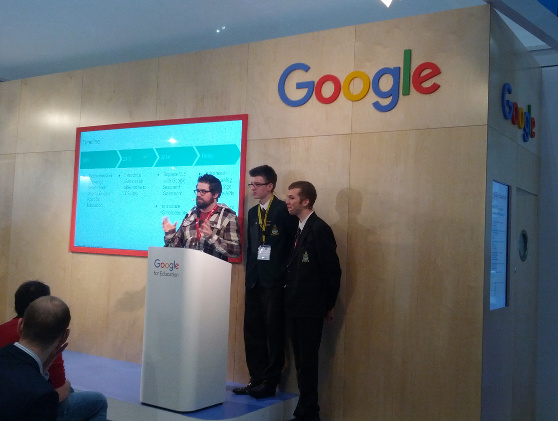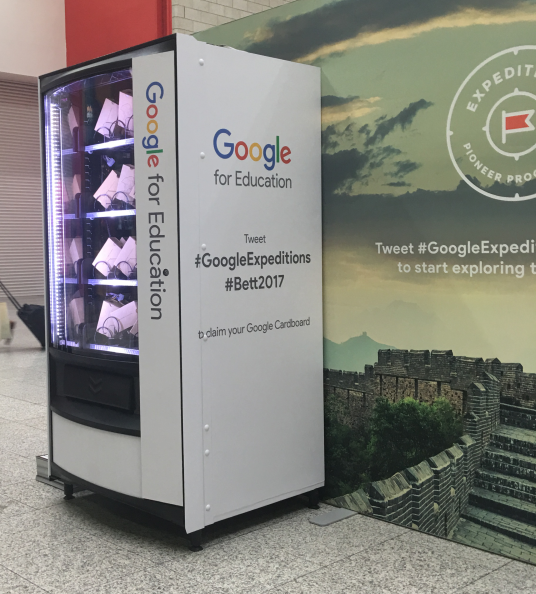One of the highlights in the eLearning calendar is the BETT show in London which happens in the last week of January every year. I usually try and send one of my team down each time to see what the latest ideas are and direction educational technology is heading. This year we all got to go courtesy of us coming runner up in the business support team of the year in the college’s annual awards. So it was a 5am start for me and my team on our journey to the capital.
The show takes up one whole side of the Excel Centre at London’s docklands and has over 250 stands showing off anything from interactive whiteboards to the latest advances in VR and 3D printing. It was that large that just walking down the main concourse from one end to the other to get to the entrance took the best part of 5 minutes.
Day 1
One our first day we started at one end of the show and had a cursory glance at each stand, making a mental note of what we wanted to concentrate on for day two. 6 hours later we had got to the other end. We had a list of about 20 stands which we wanted to go back to and find out more. We also had the chance to see a few demonstrations and talks from people through the day.

One of those was at the Google stand where a teacher and his two students were talking about how they have moved completely over to Google GSuite and that it is run in conjunction with the student cohort. It was such a powerful talk about how by letting students help to manage critical infrastructure they can give great feedback and push forward the IT and eLearning agenda. The two students in the photo had created extra applications sitting on top of the Google Suite for their own school because they saw it as a need for students. This forward thinking really brought home to me the advantages of collaborating with students rather than providing them with a prescriptive package of software.
After we walked around some it was time for another session from Google, this time about Classroom. The session was a real eye opener. The three of us had signed up to it hoping to get a sneak peak of some new features that were maybe in the pipeline. Although there were no new features shows, there were a few takeaways that we saw. Firstly, it was great to see the teacher who was demoing classrooms so enthusiastic about the package. She’s definitely drank the Google Kool-aid but it was infectious. Secondly we got to use some Acer Flip 11 chromebooks which are very nice. They are able to turn the screen over and be used as a tablet. (Note to self.. Get one of the new ones when they come out next month). But the biggest memory I have of that session was a particular teacher who couldn’t believe that Google were making the whole suite available to schools for free. After each feature was shown, he would put his hand up and say
“and this is free?”
Because we have had G Suite at our college for a little under 2 years now, its easy to forget how incredible this package is and that we don’t have to pay for it.
By the time we got to the hotel for the evening we were all completely tired and worn out but looking forward to day 2 to go and have a more details look at what was interesting.
Day 2
Once again, after a 5 minute walk down the centre of the Excel we arrived at the entrance to the show floor. But this time we knew where we wanted to go. Our first stop was extremely busy so while we were waiting we made a badge out of an LED, a battery and some copper wire. This was a smart idea as while we were creating this the people at the stand were talking to us about what the Pi could do. I made a mental note about bringing this to our demo tables at events in the college. When it has quietened down it was off to the Raspberry Pi stand. The thing which caught my eye was the PiTop.
These are fully functioning computers which are available to schools in kit form. They get the Pi and some ‘hats’ – module which allow to the Pi to do different things such as make noise or make use sensors, a 7″ LCD screen and either a desktop or laptop enclosure like the ones above. The students then put it all together, install the operating system and have a computer which they can learn to code with. What is even better is that they only cost just over £120 each.
Winding our way around the show floor past 3D printers and the many laptop storage companies we come to Tynker. Their booth had 2 Parrot Drones hovering around it, and being a bit of a Drone junky i made my way to see what was going on. They have a product which allows students to code and control mini drones such as the Parrot mambo through an iPad app. all the parts of a program are made as jigsaw pieces that are snapped together to form programs.

the students can then change the parts in white boxes to create their own programs and then compete to fly their drone against other students. This is a great way to introduce coding to students to make it fun and it’s something that I would love to have a go at myself.
Next on the list was the Microsoft Learning Centre where I sat in on a demo of OneNote Classroom. I’m still trying to get my head around what make it more than a digital PukkaPad, which is no bad thing, but i just don’t see how it can yet rival applications such as Moodle and Google Classroom effectively.
As they day was drawing to a close I reflected on what a year it has been in the eLearning world and what some of the trends are. There seemed to be a lot less stands showing off interactive whiteboards this year and more large touch displays for classrooms- Is this the death of the whiteboard as the march of progress leaves them behind? Chromebooks are not dying but are growing in popularity. My last attendance at BETT was in 2013 and I found it hard to find a Chromebook anywhere on the show floor. This year, practically all the computer makers had their own versions on display. They are also becoming more integrated and many of them have tablet capabilities added. Finally could this be
the year that VR starts to take off in the classroom. There were at least a dozen vendors at the show with headsets and applications taking advantage of VR and AR. The best and highest impact of these was a company creating immersive applications based around health education. I’ll be keeping an eye on this for the future. As always though, it was Google which stole the show in getting noticed with their product.

In the main concourse was a vending machine which gave out free Google Cardboard glasses when you tweeted it. So like any good FE eLearning person we went round a couple of times to get some to show off back at college.


